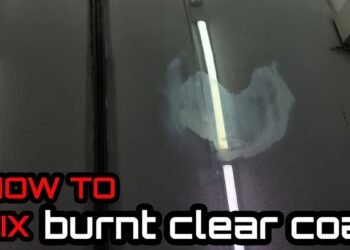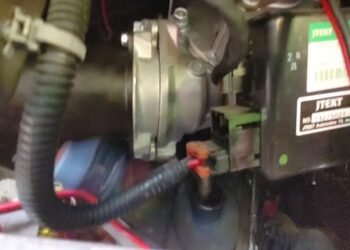Looking to give your car’s exhaust tips a fresh, bold look without spending a fortune? Plasti Dip exhaust tips might be exactly what you need.
This easy-to-use spray coating lets you customize your exhaust’s appearance with a sleek matte or glossy finish that stands out. But does Plasti Dip really hold up against the heat and grime your exhaust tips face every day? If you want to know how it performs, how to apply it correctly, and whether it’s the right choice for your ride, keep reading.
You’ll discover simple tips and expert advice to transform your exhaust tips safely and stylishly—no professional help needed. Ready to make your car look sharper and turn heads on the road? Let’s dive in.
Benefits Of Plasti Dip Exhaust Tips
Plasti Dip exhaust tips offer several benefits that make them popular among car enthusiasts. This rubberized coating changes the look and feel of your exhaust tips without permanent modification. It is easy to apply and remove, providing a versatile customization option.
These benefits go beyond just appearance. They help protect the metal and save money. Many drivers enjoy the balance between style, protection, and cost with Plasti Dip exhaust tips.
Enhanced Appearance
Plasti Dip creates a smooth, clean finish on exhaust tips. It can turn dull metal into a sleek, matte black or other colors. This improves the overall look of your vehicle. The coating hides scratches and discoloration. It gives a fresh and modern touch instantly.
Cost-effective Customization
Applying Plasti Dip costs less than buying new exhaust tips. It allows you to change colors anytime without extra tools. The peelable nature means no damage to the original surface. You can refresh your car’s style often with little expense.
Protective Coating
Plasti Dip acts as a barrier against rust and corrosion. It shields exhaust tips from weather, dirt, and road debris. This coating helps maintain the metal’s condition longer. It also resists fading and chipping from heat and use.

Credit: www.reddit.com
Choosing The Right Plasti Dip
Choosing the right Plasti Dip for your exhaust tips is key to a long-lasting and attractive finish. Exhaust tips face high heat and outdoor elements, so your Plasti Dip must be durable and heat resistant. This section explains how to pick the best Plasti Dip by looking at finishes, heat resistance, and color options.
Types Of Plasti Dip Finishes
Plasti Dip offers several finishes like matte, gloss, and satin. Matte finish gives a flat, non-shiny look. Gloss finish is shiny and smooth, adding a polished feel. Satin finish sits between matte and gloss with a soft shine. Choose a finish that matches your car’s style and your taste.
Heat Resistance Considerations
Exhaust tips get very hot during driving. Use Plasti Dip that can handle heat up to 200°F or higher. Heat-resistant Plasti Dip prevents peeling and bubbling. Avoid types that melt or lose grip under heat. Check product labels for heat tolerance before buying.
Color Options
Plasti Dip comes in many colors to match or contrast your vehicle. Popular colors for exhaust tips include black, silver, and chrome-like shades. Bright colors can create a bold look but may fade faster. Pick colors that suit your style and stand up to heat exposure.
Preparation Before Application
Proper preparation is key before applying Plasti Dip on exhaust tips. It ensures a smooth, long-lasting finish. Skipping this step can cause peeling and uneven coating. Take time to prepare the surface and surroundings carefully. This process helps the Plasti Dip stick better and look cleaner.
Cleaning Exhaust Tips
Start by cleaning the exhaust tips thoroughly. Remove dirt, grease, and rust using soap and water. Use a degreaser or rubbing alcohol for stubborn grime. Dry the surface completely with a clean cloth. A clean tip allows the Plasti Dip to bond well and last longer.
Temperature And Weather Conditions
Check the temperature before applying Plasti Dip. The ideal range is between 65°F and 85°F (18°C to 29°C). Avoid spraying in very cold or hot weather. Cold weather can cause uneven layers and cracking. Heat may dry the paint too fast, ruining the finish. Choose a dry day without wind or rain for best results.
Masking Surrounding Areas
Protect areas near the exhaust tip by masking them off. Use painter’s tape and plastic sheets or newspaper. Cover parts like the bumper and undercarriage to avoid overspray. Proper masking keeps your car clean and prevents unwanted Plasti Dip spots. Take your time to cover all edges tightly.

Credit: www.youtube.com
Step-by-step Application Guide
Applying Plasti Dip to your exhaust tips can transform their look and protect them from rust and heat damage. This step-by-step guide helps you apply the coating smoothly and evenly. Follow each stage carefully for the best results.
Applying Base Coats
Start by cleaning the exhaust tips thoroughly. Remove dirt, grease, and rust for better adhesion. Shake the Plasti Dip can well before spraying. Hold the can about 6 to 8 inches from the surface. Spray a light, even base coat in sweeping motions. Avoid heavy coats to prevent drips and runs. Let the base coat dry for about 10 minutes before applying the next layer.
Achieving Smooth Coverage
Apply additional coats to build up the thickness. Use thin, even layers rather than one thick coat. Overlap each pass slightly to avoid streaks. Keep a steady hand and maintain a consistent distance. Inspect the surface between coats to catch any uneven spots. Smooth coverage ensures a clean, professional finish on the exhaust tips.
Drying Times Between Coats
Allow each coat to dry fully before adding the next. Typical drying time is 10 to 15 minutes per coat. Avoid touching or disturbing the surface during drying. Proper drying prevents peeling and ensures durability. After the final coat, wait at least 4 hours before handling or reattaching the exhaust tips. This ensures the coating cures properly for lasting protection.
Maintaining Plasti Dip Exhaust Tips
Maintaining Plasti Dip exhaust tips keeps them looking fresh and protects the coating. Proper care extends the life of the dip and preserves the exhaust’s style. This section explains the best ways to clean, protect, and know when to reapply the coating.
Cleaning And Washing Tips
Use a soft cloth or sponge to clean the dipped exhaust tips. Avoid abrasive brushes that can scratch the surface. Wash with mild soap and warm water to remove dirt and grime. Rinse thoroughly and dry with a clean towel. Avoid harsh chemicals that can damage the Plasti Dip finish.
Protecting Against Heat And Debris
Exhaust tips get very hot during use, which can affect the Plasti Dip. Avoid spraying when the tips are hot to prevent peeling. Park in shaded areas to reduce heat exposure. Remove road debris carefully to avoid scratches. Consider applying a heat-resistant clear coat for extra protection.
When To Reapply
Check the exhaust tips regularly for chips or peeling. Reapply Plasti Dip if the coating starts to wear or fade. Light wear can be fixed with a quick touch-up spray. For heavy damage, remove the old dip before reapplying. Maintaining a smooth, even finish keeps the tips looking sharp.
Common Issues And Troubleshooting
Plasti Dip exhaust tips offer a sleek look and protection for your vehicle. Yet, some common issues can arise after application. Knowing how to spot and fix these problems helps maintain a fresh, clean finish. This section covers typical troubles and easy fixes.
Peeling And Chipping
Peeling or chipping often happens due to poor surface prep. Dirt, oil, or rust can stop Plasti Dip from sticking well. Always clean the exhaust tips thoroughly before spraying.
Thin or uneven coats increase the chance of peeling. Apply several light layers, letting each dry fully. Thick coats dry poorly and flake off easily.
Physical damage from road debris or cleaning tools may also cause chips. Avoid harsh scrubbing or sharp objects near the dipped areas.
Dealing With Heat Damage
Exhaust tips face high heat. Plasti Dip can soften or discolor if exposed to excessive temperatures. Use high-temp resistant Plasti Dip variants for better durability.
Allow the coating to cure completely before driving. Fresh layers are more sensitive to heat and may peel or bubble.
Heat damage often appears as bubbling or color changes. If this happens, reapply after removing the damaged coating.
Removing Plasti Dip Safely
Removing Plasti Dip is simple and safe if done right. Start by peeling from an edge; it should come off in sheets.
Use warm soapy water and a soft cloth to clean leftover residue. Avoid strong chemicals that can damage the metal.
For stubborn spots, use rubbing alcohol or a plastic scraper gently. Always test on a small area first to avoid scratching.
Creative Customization Ideas
Plasti Dip exhaust tips offer a unique way to personalize your vehicle’s look without permanent changes. This flexible coating lets you explore many creative styles. You can change colors, finishes, and even add patterns. These options help your car stand out in a crowd. Let’s explore some creative customization ideas for your exhaust tips.
Matte Vs Glossy Finishes
Matte finishes give a smooth, non-shiny look. They create a subtle, modern appearance that hides dirt well. Glossy finishes shine brightly and catch the eye. They add a bold, polished style to your exhaust tips. Both finishes protect the metal from rust and wear. Choose matte for a sleek, understated look or glossy for a vibrant, high-impact style.
Combining Colors And Patterns
Mixing colors can make your exhaust tips truly unique. Try blending dark shades with bright colors for contrast. Patterns like stripes or dots add fun details. Use painter’s tape to create clean lines before spraying. Layering different colors creates depth and texture. Experiment with metallic or neon Plasti Dip for extra flair. Custom patterns show your personal style boldly and clearly.
Complementing Overall Vehicle Style
Your exhaust tips should match your car’s design. For a sporty car, bright or metallic colors enhance aggressive looks. Classic cars pair well with matte black or deep gray finishes. Luxury vehicles benefit from glossy or chrome-like effects. Consider your car’s paint color and trim when choosing Plasti Dip shades. Harmonizing your exhaust tips with your vehicle’s style improves overall appearance and appeal.
Where To Buy And Cost Factors
Finding the right place to buy Plasti Dip for your exhaust tips matters. Prices vary by brand, quality, and package size. Understanding cost factors helps plan your budget smartly. This section covers trusted suppliers, cost differences between DIY and professional jobs, and budgeting tips for materials.
Trusted Suppliers And Brands
Buy Plasti Dip from well-known stores or online shops. Popular brands include Plasti Dip brand, Performix, and Dupli-Color. Check product reviews to ensure quality. Avoid unknown sellers to prevent fake or poor products. Local hardware stores and automotive shops often stock Plasti Dip. Online marketplaces like Amazon offer a wide selection and user feedback.
Diy Vs Professional Application Costs
Doing it yourself saves money but needs time and care. A can of Plasti Dip costs $6 to $15, covering one or two exhaust tips. Professional services charge $50 to $150 depending on labor and finish quality. Professionals ensure even coats and durability. DIY may require extra cans if mistakes happen. Choose based on budget, skill, and desired results.
Budgeting For Materials
Besides Plasti Dip cans, budget for prep tools like sandpaper and cleaning supplies. Masking tape protects areas you don’t want to spray. Gloves and respirators improve safety. One project may need 2-4 cans depending on layers and tip size. Set aside extra funds for mistakes or touch-ups. Proper budgeting avoids running out mid-project.

Credit: www.m3post.com
Frequently Asked Questions
Does Plasti Dip Work On Exhaust Tips?
Plasti Dip works on exhaust tips but may peel due to high heat exposure. Proper prep and multiple coats improve durability. It resists weather but can degrade with extreme heat. Regular maintenance extends its life, but expect limited longevity on hot surfaces like exhaust tips.
How Much Heat Can Plasti Dip Withstand?
Plasti Dip can withstand heat up to approximately 200°F (93°C). It is not suitable for constant exposure to high temperatures like exhaust tips. Prolonged heat may cause peeling or melting. Use high-heat coatings for areas above 200°F for better durability and safety.
How Long Does Plasti Dip Last?
Plasti Dip lasts 1 to 3 years outdoors with proper application and care. Indoor use may extend its life. Regular maintenance improves durability.
Does Plasti Dip Just Peel Off?
Plasti Dip peels off easily as a flexible rubber coating. Proper thickness ensures clean removal without residue.
Can Plasti Dip Handle The Heat From Exhaust Tips?
Plasti Dip can resist moderate heat but may peel or melt with very high exhaust temperatures.
Conclusion
Plasti Dip offers a simple way to change exhaust tips’ look. It resists heat and peels off easily when needed. Applying it carefully ensures a smooth, lasting finish. This method suits those wanting a fresh style without permanent changes. Regular cleaning keeps the coating looking new longer.
Overall, Plasti Dip helps protect and personalize exhaust tips affordably and quickly.

















